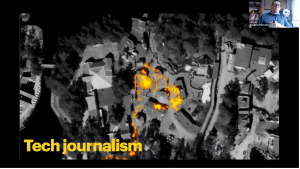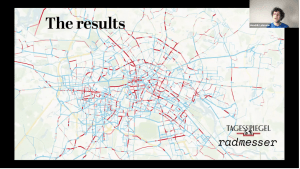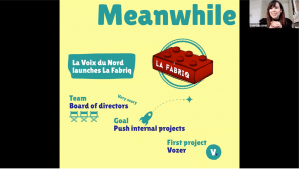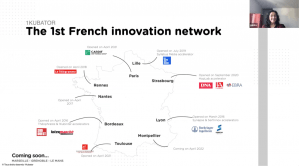GAMI Briefing #4: Media Labs session (17.02.22)
Media labs, innovation networks, accelerators and start-ups from across Europe, the fourth edition of GAMI’s regular online briefings covered a diverse range of innovations and ways to innovate.
These included new approaches to broadcast technology, AI-powered podcast experiences, open innovation networks that supported media and data-journalism powered by the internet of things.
- Norway’s NRKbeta demonstrated how it delivers technology innovation and market insights to the country’s public broadcaster.
- Der Tagesspiegel’s Innovation Lab described how it uses the power of audiences and interactive visualisation to conduct and convey data journalism.
- France’s La Voix du Nord (LVDN)’s incubator – La Fabriq – outlined some of the success products it had developed.
- The session also introduced the 1Kubabor open innovation network and its Syllabus media accelerator also linked to LVDN
- podcast start-up Bwlb showed its ACCORDION product, which allows users to change the duration of podcasts but without losing the essence and integrity of the content.
NRKbeta: R&D, Technology Journalism, Insights
Anders Hofseth, strategic advisor and journalist at NRKbeta lab within the Norwegian Broadcasting Corporation, kicked off the session by explaining NRKbeta’s core activities. A team of seven conduct research and development around new tech, products and processes – creating new approaches to broadcast media. Hofseth discussed a range of initiatives that formed part of their R&D work. These included audio sensitive cameras developed in house using Arduino board and Go-Pro cameras that are able to detect audio from specific speakers, and form there automated video always showing the speaker. Hofseth said this tech has been used on the main broadcast channel and across the web.
The second activity the lab runs is technology journalism; creating editorial material for public output. Hofseth described a project where the team purchased a big data set to understand how individuals’ data could be used by third parties.

“We found vulnerable targets like politicians with military people who could have been targeted and blackmailed, and we could find people like me and you’d see them go to work, go to hospital and see them meeting people.”
When speaking to an individual who’s data had been captured and analysed, Hofseth said “he was really surprised and quite freaked out when we found him and told him that we know exactly where you were two years ago.”
Speaking broadly about these activities, Hofseth explained they are “really about seeing where the technical possibilities are aligning with your goals and charting what things you can do with them to help you reach your goals better.”
The lab also creates insights to benefit the broadcaster more strategically. Discussing the buzz around apps such as Clubhouse, Hofseth said the lab navigates fads – enabling their organisation to protect their resources and concentrate on future trends that can provide real benefit.
“[Our] purpose is really helping NRK to carry that public service [role] into the 21st century because we need to understand things and do the right stuff and not do too much of the wrong stuff if we want to be around in 50 years.”
Read a full article about NRKbeta here
Der Tagesspiegel Innovation Lab: new forms of storytelling; empowering journalism
A team of journalists, designers and coders, Der Tagesspiegel’s Innovation lab is involved in a range of data journalism and tech development projects. At the heart of the lab is collaboration, both within their organisation and beyond it.
Hendrik Lehmann, head of the lab, explained that one of the key motivating factors for the lab was to create ‘empowering journalism’.
This includes equipping colleagues in Der Tagesspiegel with tools to create journalism in a data-driven age, empowering citizens in a complex digital ecosystem, involving users in research, collaborating with scientists and start-ups, translating global problems into local and personal stories and creating stories that connect with people emotionally and politically.
Lehmann provided a range of project examples to outline their work. Radmesser used the ‘journalism of things’ – a take on the internet of things, to explore safety for cyclists. The team created 100 sensors and distributed them among citizens for use on their bikes. The sensors could detect how close cars were to the bikes. The initial phase of the project recorded 16,000 events and found that 56% broke safe passing rules. The sensors were open sourced and are now used in other cities within Germany and beyond.

“The results were very unique and we produced this map of it – you could look for your address in and visualize areas in the city where it was especially dangerous. It changed a lot of the discourse in Germany. It led to a change in the law on the national level, not only that project, but the wider discussion around it.”
Spectrum of projects
The lab leader also talked about the breadth of project they’ve been involved in. These range across Wem Gehōrt Berlin? an international investigation of property investment and ownership – starting in Berlin, and later expanding to multiple cities. Interactive tools that allow readers to understand environmental impact – such as a calculator that lets users to understand how eco-friendly (or not) their meals are.
Covid
The team have been involved in Covid coverage at Der Tagesspiegel in a number of ways. One example Lehman provided was a Covid tracking map initially created at the beginning of the pandemic. Lehmann explained that it’s been the most successful article Der Tagesspiegel has ever had.
“It has a few dozen million views. Every day, it’s among the top viewed articles, and the main function of this is that people are able to look for their area and see the results and look for certain countries and also see the results. Also, it has comparison features where we develop different kind of data visualisations and you can highly customize it. … We tracked [use] and it’s about 10 clics per visit, so people use 10 different tools and 10 kind of inputs to visit, which normally would be unlikely. The engagement on this website is really high”
Read more about Der Tagesspiegel innovation lab here
New incubator: new solutions at La Voix du Nord
Next up was Lucie Delorme, the head of the La Fabriq incubator at la Voix du Nord in Lille. La Voix du Nord is an 80-year-old newspaper and website, which reaches one million readers a day. Delorme described her and the organisation’s innovation journey, which began six years ago with a design thinking process. This saw 20 employees taking one day a week for five weeks to create new products and services, and the creation of an incubator.
Delorme explained the incubator is centred on a simple concept – “everyone in the company can have a very good idea. And it would be so great to push it and to help [it to be] developed.” The incubator supports a range of activities “It’s not only new products, new mediums, it’s also new processes, new ways to save time or money. It’s just the opportunity, the time and the money to achieve those ideas,” she explained.

A range of products have been developed through the incubator since it started.
- Vozer: an ‘urban pure player’ that creates content for millennials without any print product. Incubated for six months, the product now has 250,000 readers and has a viable business model, staffed with four team members.
- Pigeon Master: North of France sees a large community of pigeon fanciers. This is an auction sales platform and media site. Content is created by journalists from across the news organisation
- Ta Voix: aimed at teenaged readers and provides news content on Instagram and Snapchat and media education within schools – delivering information around fake news and how to source valid information within our digital ecosystem.
Delorme also talked about La Fabriq 2.0, which now has a team of eight taken from across the organisation, and supports new ideas and products and provides design thinking training.
“We managed to organize a very cool design thinking training. That was very good for us because you can be a very good journalist, you can be a very good web analyst, but you need training in design thinking if you want to work in an incubator. So this is what we did … all the eight good coaches are now well trained. This is the best way for us to help people incubate within La Fabriq.”
National and international open innovation networks
Speaking next was Paola Villalba, head of Accélérateur Syllabus Média, 1Kubator La Voix du Nord. Villalba explained the link between her organisation and La Fabriq.
1Kubator is an open innovation network, the first in France, and has a range of incubators across the country – including with la Voix Du Nord – and beyond. Working in countries such as China, Burkina Faso and Senegal.
“We facilitate innovation at different levels from the person looking to explore enterprise shape through information where we finance and invest in startups and acceleration, and all the way to working with corporate groups and helping them tackle digital transformation. We want to make it possible for all of them to benefit from our network, have access to different resources and help startups become nationwide a lot faster.”

Villalba outlined the type of activity the network creates in order to build this innovation:
“We have innovation, challenges, entrepreneurship, extra partnership hackathons and different design. And yes, design thinking bootcamps for them. And the other one that we have is very specific, which is the open innovation accelerators. [Our] ambition is to create an innovation network for media groups where what we do with one media and one startup may be replicated in other local newspapers. This works in France because these media groups are not in competition with each other.”
Talking about the Syllabus Media accelerator at La Voix du Nord, Villalba explained that this accelerator enables the publisher to connect with start-up to accelerate its digital transformation through identifying innovation solutions to the challenges they face.
Syllabus media works in two ways. Identifying trends and opportunities externally or identifying internal needs within the publisher, and then working with start-ups to help connect them to a challenge. These start-ups can help shorten the time to market to help new solutions. The start-ups can also take advantage of training and development opportunities via the accelerator and network.
The programmes last between 6 and 12 months, and it has worked with a range of organisations spanning education, advertising and content creation. It tests products and business models quickly and effectively. There are three main areas that the network focusses on:
- Diversification: new business models, new products and solutions
- New types of content: exploring new channels such as podcasts, virtual reality and augmented reality
- New tools and solutions: internal systems that allow publishers to increase efficiency, understand audience data and/create better content
Two successful examples are ‘Rematch’, which collects video highlights from amateur sports and amplifies these on social channels. Clubs upload directly to the app and journalists can use the content on special programming and outputs. ‘Trusty’ is a dynamic job board solution that is still being accelerated in conjunction with La Voix du Nord. It allows those hosting jobs pages to customise their websites and offer different services.
Bwlb: ACCORDION
Finally, Andy Taylor introduced his start-up Bwlb. Based in Wales, Bwlb’s ACCORDION creates “smart podcasts”, which sees the audio adjusted to fit the time users have available. Taylor suggested that this increases the “amount of control and convenience that the listeners can have in the future”. Using AI tech, Bwlb aims to provide shortened podcasts that still retain the core story. Essentially, superfluous elements are removed so the essence of the podcasts are retained. Users can define how much time they have, and the audio is edited to the right play time.
Taylor explains: “We think that there needs to be a breakthrough in audio, specifically in podcasting, where listeners get a lot more control and convenience in the same way they have with visual media. So this is what accordion aims to do, it gives the listener a chance to adjust the duration of any podcast episode without losing structure, tone or listenability.”

Bwlb is working on full automation and is interesting in working with small, medium or large organisations to take the product to the next level. The key element behind the product is the experience – creating a seamless audio experience even though it is condensed.
“It’ll still sound like the podcast you know and love,” Taylor added.
The next GAMI Briefing will take place online before the summer and hopefully a new edition of the “in-person” Media Labs days will be taking place later in the year…

